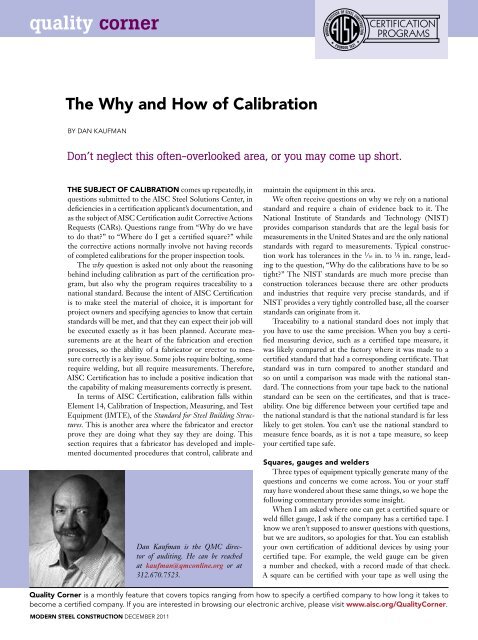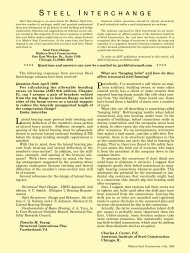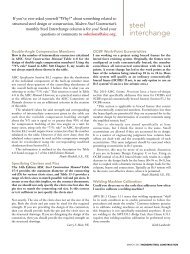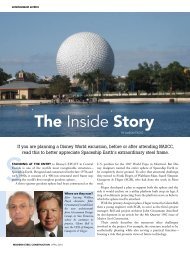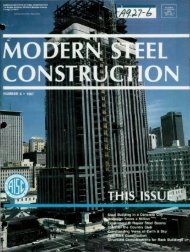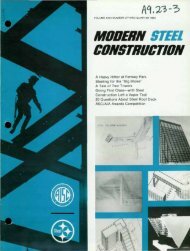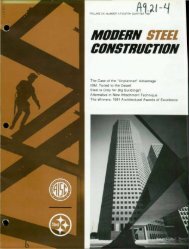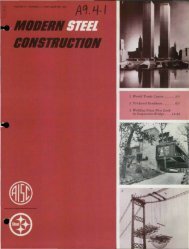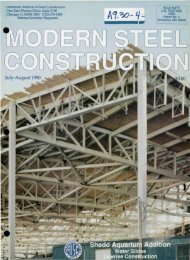The Why and How of Calibration - Modern Steel Construction
The Why and How of Calibration - Modern Steel Construction
The Why and How of Calibration - Modern Steel Construction
You also want an ePaper? Increase the reach of your titles
YUMPU automatically turns print PDFs into web optimized ePapers that Google loves.
quality corner<br />
<strong>The</strong> <strong>Why</strong> <strong>and</strong> how <strong>of</strong> <strong>Calibration</strong><br />
by dan Kaufman<br />
Don’t neglect this <strong>of</strong>ten-overlooked area, or you may come up short.<br />
ThE SUbjECT Of CaLIbRaTION comes up repeatedly, in<br />
questions submitted to the AISC <strong>Steel</strong> Solutions Center, in<br />
deficiencies in a certification applicant’s documentation, <strong>and</strong><br />
as the subject <strong>of</strong> AISC Certification audit Corrective Actions<br />
Requests (CARs). Questions range from “<strong>Why</strong> do we have<br />
to do that?” to “Where do I get a certified square?” while<br />
the corrective actions normally involve not having records<br />
<strong>of</strong> completed calibrations for the proper inspection tools.<br />
<strong>The</strong> why question is asked not only about the reasoning<br />
behind including calibration as part <strong>of</strong> the certification program,<br />
but also why the program requires traceability to a<br />
national st<strong>and</strong>ard. Because the intent <strong>of</strong> AISC Certification<br />
is to make steel the material <strong>of</strong> choice, it is important for<br />
project owners <strong>and</strong> specifying agencies to know that certain<br />
st<strong>and</strong>ards will be met, <strong>and</strong> that they can expect their job will<br />
be executed exactly as it has been planned. Accurate measurements<br />
are at the heart <strong>of</strong> the fabrication <strong>and</strong> erection<br />
processes, so the ability <strong>of</strong> a fabricator or erector to measure<br />
correctly is a key issue. Some jobs require bolting, some<br />
require welding, but all require measurements. <strong>The</strong>refore,<br />
AISC Certification has to include a positive indication that<br />
the capability <strong>of</strong> making measurements correctly is present.<br />
In terms <strong>of</strong> AISC Certification, calibration falls within<br />
Element 14, <strong>Calibration</strong> <strong>of</strong> Inspection, Measuring, <strong>and</strong> Test<br />
Equipment (IMTE), <strong>of</strong> the St<strong>and</strong>ard for <strong>Steel</strong> Building Structures.<br />
This is another area where the fabricator <strong>and</strong> erector<br />
prove they are doing what they say they are doing. This<br />
section requires that a fabricator has developed <strong>and</strong> implemented<br />
documented procedures that control, calibrate <strong>and</strong><br />
MODERN STEEL CONSTRUCTION december 2011<br />
Dan Kaufman is the QMC director<br />
<strong>of</strong> auditing. He can be reached<br />
at kaufman@qmconline.org or at<br />
312.670.7523.<br />
maintain the equipment in this area.<br />
We <strong>of</strong>ten receive questions on why we rely on a national<br />
st<strong>and</strong>ard <strong>and</strong> require a chain <strong>of</strong> evidence back to it. <strong>The</strong><br />
National Institute <strong>of</strong> St<strong>and</strong>ards <strong>and</strong> Technology (NIST)<br />
provides comparison st<strong>and</strong>ards that are the legal basis for<br />
measurements in the United States <strong>and</strong> are the only national<br />
st<strong>and</strong>ards with regard to measurements. Typical construction<br />
work has tolerances in the 1 ∕16 in. to 1 ∕8 in. range, leading<br />
to the question, “<strong>Why</strong> do the calibrations have to be so<br />
tight?” <strong>The</strong> NIST st<strong>and</strong>ards are much more precise than<br />
construction tolerances because there are other products<br />
<strong>and</strong> industries that require very precise st<strong>and</strong>ards, <strong>and</strong> if<br />
NIST provides a very tightly controlled base, all the coarser<br />
st<strong>and</strong>ards can originate from it.<br />
Traceability to a national st<strong>and</strong>ard does not imply that<br />
you have to use the same precision. When you buy a certified<br />
measuring device, such as a certified tape measure, it<br />
was likely compared at the factory where it was made to a<br />
certified st<strong>and</strong>ard that had a corresponding certificate. That<br />
st<strong>and</strong>ard was in turn compared to another st<strong>and</strong>ard <strong>and</strong><br />
so on until a comparison was made with the national st<strong>and</strong>ard.<br />
<strong>The</strong> connections from your tape back to the national<br />
st<strong>and</strong>ard can be seen on the certificates, <strong>and</strong> that is traceability.<br />
One big difference between your certified tape <strong>and</strong><br />
the national st<strong>and</strong>ard is that the national st<strong>and</strong>ard is far less<br />
likely to get stolen. You can’t use the national st<strong>and</strong>ard to<br />
measure fence boards, as it is not a tape measure, so keep<br />
your certified tape safe.<br />
Squares, gauges <strong>and</strong> welders<br />
Three types <strong>of</strong> equipment typically generate many <strong>of</strong> the<br />
questions <strong>and</strong> concerns we come across. You or your staff<br />
may have wondered about these same things, so we hope the<br />
following commentary provides some insight.<br />
When I am asked where one can get a certified square or<br />
weld fillet gauge, I ask if the company has a certified tape. I<br />
know we aren’t supposed to answer questions with questions,<br />
but we are auditors, so apologies for that. You can establish<br />
your own certification <strong>of</strong> additional devices by using your<br />
certified tape. For example, the weld gauge can be given<br />
a number <strong>and</strong> checked, with a record made <strong>of</strong> that check.<br />
A square can be certified with your tape as well using the<br />
Quality Corner is a monthly feature that covers topics ranging from how to specify a certified company to how long it takes to<br />
become a certified company. If you are interested in browsing our electronic archive, please visit www.aisc.org/QualityCorner.
3-4-5 rule, or if you really want, by using the Pythagorean<br />
<strong>The</strong>orem. Here’s a tip I saw that isn’t widely known: you<br />
can adjust a square. If your square is too tight (i.e., less<br />
than 90 degrees), you can open it up by using a punch to<br />
make an indentation close to the inside <strong>of</strong> the corner. <strong>The</strong><br />
deformation will cause the surrounding metal to exp<strong>and</strong><br />
<strong>and</strong> push the legs apart. If the legs are too far apart, make<br />
an indentation near the tip <strong>of</strong> the heel. It doesn’t take too<br />
much <strong>of</strong> an indentation to make this work.<br />
Another measuring device frequently involved in questions<br />
<strong>and</strong> CARs is the paint thickness measurement device.<br />
<strong>The</strong> common name for this is the DFT gauge, for dry film<br />
thickness. <strong>The</strong> main calibration issue is how frequently<br />
they must be checked. SSPC: <strong>The</strong> Society for Protective<br />
Coatings says that DFT gauges need to be checked daily<br />
when in use.<br />
In the case <strong>of</strong> DFT gauges, especially the magnetic<br />
variety, they are not calibrated by you; rather, they are<br />
verified. <strong>The</strong>se words are sometimes used in the wrong<br />
context. This isn’t surprising because they are not well<br />
defined in references. Verification is checking to see how<br />
close a device is to the st<strong>and</strong>ard, but not making any<br />
adjustments to it. <strong>Calibration</strong> normally consists <strong>of</strong> checking<br />
a device <strong>and</strong> then adjusting it so that it measures correctly<br />
according to the st<strong>and</strong>ard. Of course, some DFT<br />
gauges cannot be adjusted without sending them to the<br />
manufacturer or a qualified lab.<br />
Another measurement, but one that is not so easily<br />
seen, involves the operation <strong>of</strong> welding machines. We<br />
can read volts <strong>and</strong> amps from a meter readout on most<br />
welding machines, amps on some, <strong>and</strong> nothing on some.<br />
Furthermore, none <strong>of</strong> this is in the final product, so what’s<br />
the fuss?<br />
AISC Certification requires the use <strong>of</strong> AWS D1.1 or<br />
D1.5. Welding quality is heavily influenced by the process<br />
parameters: volts, amps, wire feed speed, etc. Weld Procedure<br />
Specifications (WPSs) are required for all structural<br />
steel welding. While most welders (the people) are con-<br />
fident that they know how to set these parameters to get<br />
a good weld, there can be defects that are not visible to<br />
the eyes <strong>of</strong> the welder but caused by the settings used—<br />
therefore, there are WPSs required as defined by AWS<br />
to dictate the settings <strong>and</strong> conditions required for a specific<br />
weld type. Shouldn’t we be checking the machines<br />
to guard against welding outside the ranges set for a weld<br />
type? What does AWS say about this?<br />
<strong>The</strong> condition <strong>of</strong> welding machines is addressed with<br />
the same sentence in both documents. In D1.1, it is Clause<br />
5.11—Welding <strong>and</strong> Cutting Equipment; <strong>and</strong> in D1.5 it is<br />
Clause 3.12—General Requirements:<br />
“All welding <strong>and</strong> thermal-cutting equipment shall be so<br />
designed <strong>and</strong> manufactured, <strong>and</strong> shall be in such condition,<br />
as to enable designated personnel to follow the procedures<br />
<strong>and</strong> attain the results described elsewhere in this code.”<br />
AISC <strong>and</strong> QMC are not going to provide an interpretation<br />
<strong>of</strong> AWS rules, because AWS is the welding expert.<br />
You will need to look at your situation <strong>and</strong> establish how<br />
you are going to show that you are following the AWS<br />
requirement.<br />
A final tip would be to thoroughly review calibration<br />
reports that you receive from outside calibration laboratories<br />
for such items as a Skidmore Bolt Tension Calibrator,<br />
etc. I once reviewed a fabricator’s calibration reports<br />
<strong>and</strong> realized the laboratory had failed the specific machine.<br />
<strong>The</strong> fabricator thought he was in the clear, because he<br />
had received an “<strong>of</strong>ficial report,” although he didn’t actually<br />
review it. Now is a great time to review your shop’s<br />
calibration reports <strong>and</strong> requirements to make sure you<br />
are up to date.<br />
<strong>Calibration</strong> doesn’t have to be difficult, but if you let<br />
it get out <strong>of</strong> h<strong>and</strong>, you can end up in a tough spot. Doing<br />
a calibration takes a lot less time <strong>and</strong> effort than investigating<br />
why parts don’t fit, or going out to the jobsite to<br />
h<strong>and</strong>le a claim. One claim can also lead to much higher<br />
expenses than meeting a simple calibration st<strong>and</strong>ard.<br />
december 2011 MODERN STEEL CONSTRUCTION


